Taha Disk®2
Bringing efficiency
to ...
Taha-Disk heat exchangers combine the best features of both gasket plate and shell-and-tube heat exchangers. They offer the highest operating pressures and temperatures, and the highest efficiency among all heat exchanger types. The fully-welded construction, using laser welding, ensures high reliability and minimal leakage, even at extremely low or high temperatures and pressures.
In a Taha-Disk® exchanger, the corrugated circular plates are divided into two halves, with inlet and outlet ports for fluid flow. The cold fluid enters the exchanger and is distributed through the narrow spaces between the plates. The hot fluid enters the shell and flows through the remaining space, transferring heat to the cold fluid. This design provides flexibility for various piping systems and enhances overall exchanger efficiency.
Function
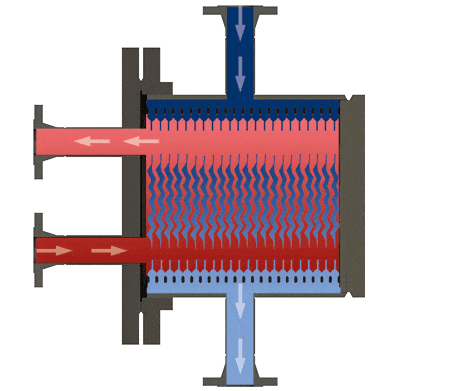
Different materials
for different applications.
Materials and Construction
Taha-Disk® exchangers are constructed using high-quality materials, including:
Specifications
- AISI 304L
- AISI 316L
- Alloy 904L
- Alloy 254 SMO
- Nickel 201/200
- Hastelloy C-276
- Hastelloy C-2000
- Hastelloy HYBRID-BC1
Plates
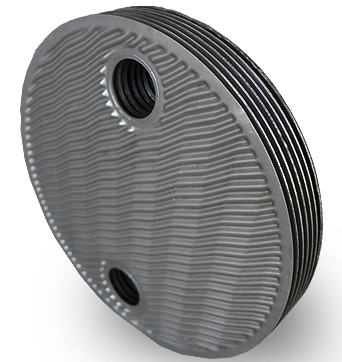
- AISI 304L
- AISI 316L
- Alloy 904L
- Alloy 254 SMO
- Nickel 201/200
- Hastelloy C-276
- Hastelloy C-2000
- Hastelloy HYBRID-BC1
Shell
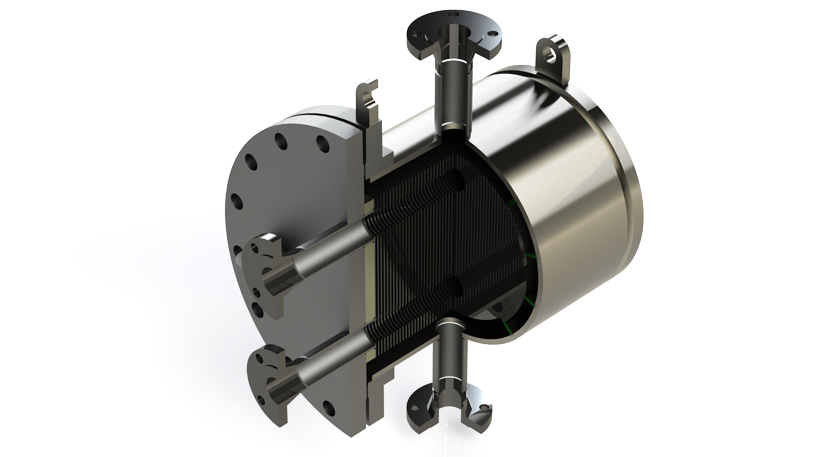
In all heat exchanger plates, the hot and cold fluids can flow in co-current, counter-current, or cross-flow arrangements. This feature increases the flexibility of the heat exchanger in adapting to specific piping systems and enhances its efficiency.
Types of Disk & Shells (based on flow)
In this arrangement, the fluids flow in opposite directions. This maximizes the temperature gradient and improves heat transfer efficiency. It is suitable for applications that require the outlet temperatures of the two fluids to approach each other closely.
Counter-Current Flow:
Both fluids flow in the same direction. This configuration is typically used when the temperature difference between fluids is moderate and minimal pressure drop is required.
Co-Current Flow:
Design and innovation
TGT has optimized the geometry of its fully welded Disk & Shell heat exchangers through extensive simulations. The unique chevron pattern employed in the plates represents a significant advancement in heat exchanger design. Other key features include:
- Precision laser cutting of plates for optimal fit and performance.
- Exclusive use of laser cutting and up to 3 kW laser welding processes.
- Formation of heat transfer plates using the largest hydraulic press in the Middle East, manufactured by TGT.
Disk & Shell heat exchangers must be designed and manufactured according to international standards. Some of the important standards include the following:
- API Standard 662 Part 1 (ISO 15547-1)
- ASME BPVC Section VIII Division 1
- ASME B16.5 (Flanges)
- EN 13445 (Optional)
- EN 1092-1 (Optional Flanges)
- TEMA (Tubular Exchanger manufacturers Association)
Product Features
- Plate Pack
- Shell
- End Plate
- First Plate
- Slip-on Flange
- Weld-Neck Flange
- Plate Pack Cover
- Spiral Gasket
- Saddle
- Bolt
Disk & Shell Bill of Material:
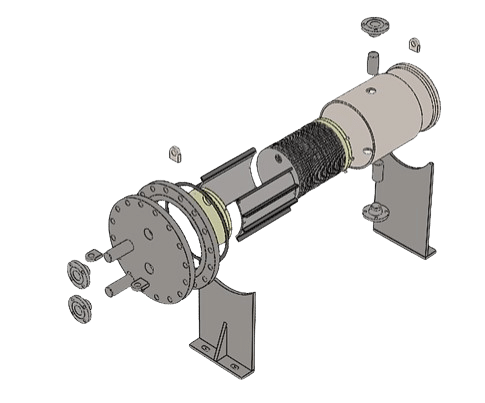
TGT air-to-air heat exchangers optimize both water and energy efficiency by heat exchanging between warm and cold air. During the process, steam in the warm air condenses, producing usable water, making these exchangers highly beneficial and economically viable for industries facing water and energy shortages.
Key advantages of recuperators include
- Gasket-free structure: Suitable for use in toxic, flammable, high-temperature, and high-pressure environments.
- High temperature and pressure resistance: Capable of withstanding pressures up to 50 bar and temperatures up to 600°C.
- Low fouling rate: The multi-pass design and flow turbulence increase shear stress, significantly reducing the fouling rate in the Oblong heat exchanger.
- Compact design: The installation space required for the Disk-and-Shell heat exchanger is much smaller than that of an equivalent Shell-and-Tube exchanger.
- Lightweight and efficient: Due to their high efficiency, these heat exchangers have a smaller volume and lower weight compared to Shell-and-Tube heat exchangers.
Advantages
- The Taha-Disk® design offers flexibility in flow patterns (counter-current, parallel, cross-flow) to suit various process requirements.
- The fully-welded construction ensures a long service life and minimal maintenance.
- TGT’s expertise in heat exchanger design and manufacturing enables them to provide customized solutions for complex applications.
Additional Notes
In general, Disk-and-Shell heat exchangers have a wide range of applications across various industries. Some of these applications include:
- Oil and gas industries
- Chemical and petrochemical processes
- Industrial gas cooling
- Power generation plants
- Nuclear industries
- Food and pharmaceutical industries
- Steel and cement industries
Applications
What makes us different?
Competitive Advantages
Design
Our products are designed, produced, and supplied across 8 main sites, and this feature provides a unique and strategic flexibility in meeting the industrial needs of the customers. The use of the most advanced and up-to-date equipment and machinery, along with a team of elite and experienced engineers, has enhanced both the quality and quantity of our products. All production equipment at TGT, such as heat exchangers, due to their high variety, must be designed and simulated using specialized software and tailored to specific working conditions. All of these products are designed and simulated with the help of specialized software developed by this knowledge-based company.
Manufacturing and quality:
TGT maintains complete control over the entire Disk & Shell’s production cycle. From initial design to final assembly, all components are engineered in-house, ensuring optimal performance and customization. This comprehensive approach allows for precise tailoring of heat exchangers to specific process requirements.
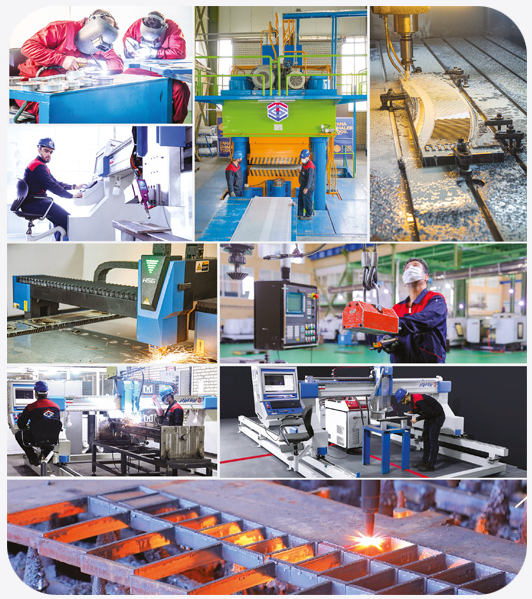
Strict quality control
TGT’s manufacturing process, from raw material sourcing to final assembly, is rigorously controlled by a dedicated quality assurance team. Every step, including plate forming, machining, painting, and Welding, is monitored to ensure adherence to the highest quality standards.
Key inspection techniques, such as Magnetic crack detection of welding, non-destructive penetrant spray inspection in welding, Ultra-sonic weld test and strict dimension inspection in plate manufacturing process are employed to meet global quality benchmarks.
Service (24/7)
The largest specialized heat exchanger repair center in the Middle East
TGT repair and maintenance service center is the largest specialized center for repairing heat exchangers in the country. Expert engineers can disassemble, repair, recondition and clean any heat exchanger devise on our service center sites. Technical experts initially check all parts of the heat exchanger based on any possible drafts provided by the customers. After the damaged parts are located, possible approaches are examined by the engineering team in order to repair the heat exchangers. At last, after taking the necessary approach for servicing the heat exchanger our technicians prepare the equipment for packing, and shipping to destination.